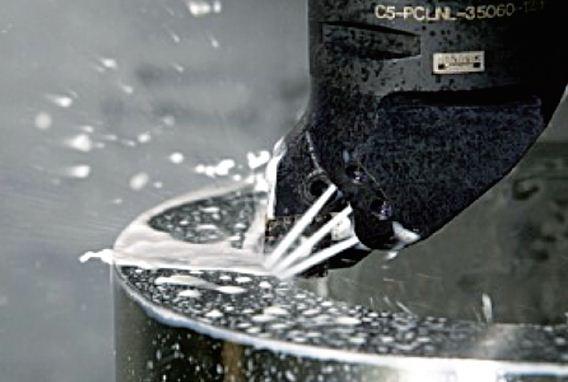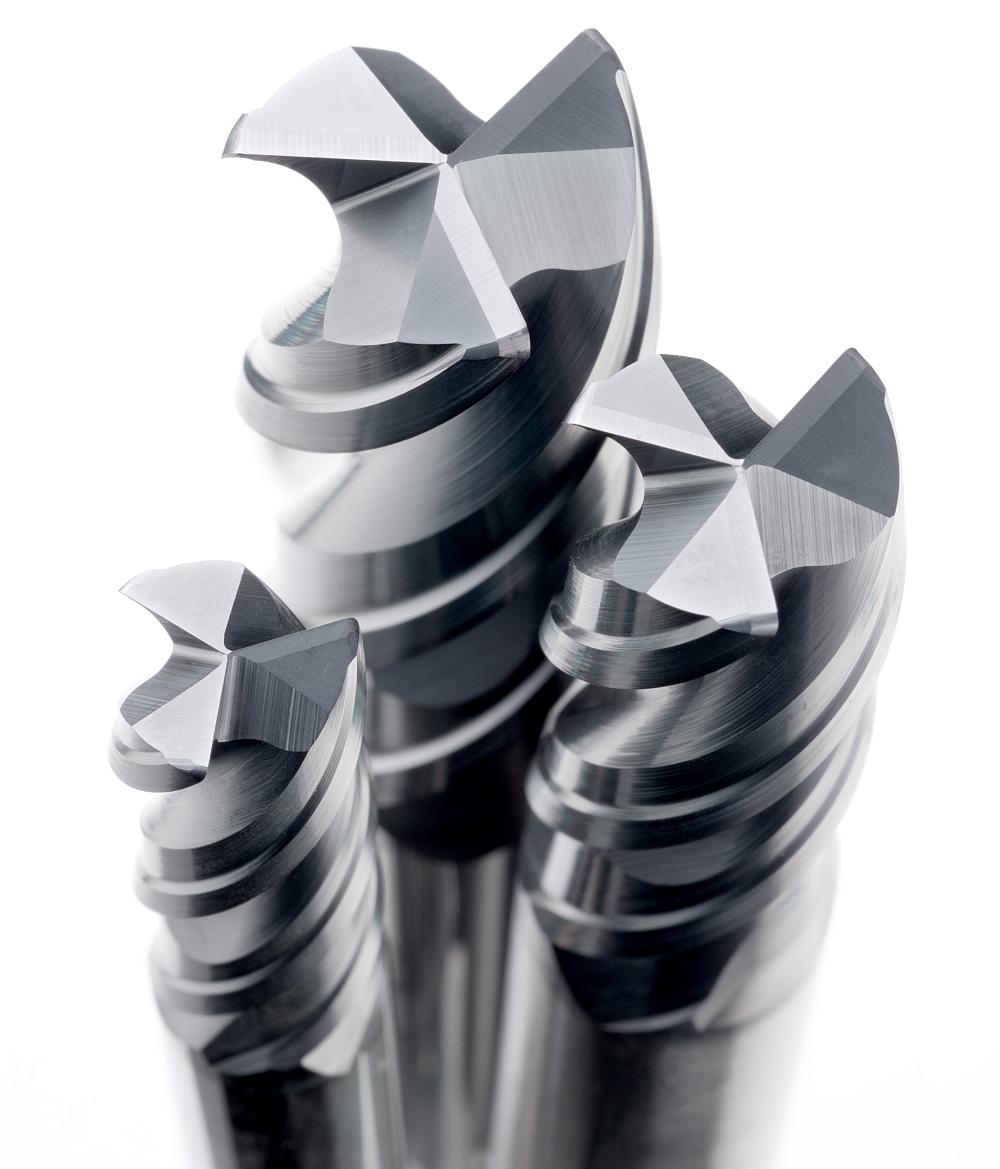- FMA
- The Fabricator
- FABTECH
- Canadian Metalworking
Staying Sharp
Tips on maximizing cutting tool life.
- By Nate Hendley
- August 10, 2015
- Article
- Cutting Tools
We posed an open-ended question to cutting tool experts: what’s the best way to maximize tool life? Answers we received ranged from highly technical discourses about cutting edges and angles to simple common sense (don’t push your tool past its suggested parameters).
One query that elicited widespread agreement centered on the factors that diminish tool life. “Heat has the greatest impact on tool life and the speed at which we run has the biggest effect on heat,” says Brian MacNeil, milling products and application specialist, Sandvik Canada Inc. in Mississauga, Ontario. “Heat is generated four ways. Listed in the order of impact on tool life: (Vc) speed, (Ae) arc of engagement, (Fz) feed, (Ap) depth of cut.”
“When we speak about wear, it can’t be avoided. The best wear is slow controlled flank wear. How quickly that wear comes to us is impacted by the type of grade we choose based on material, interruption caused by material conditions and component features in the cutting zone,” MacNeil continues.
There was also general agreement that milling is the application that contributes the most to tool wear.
“Milling is very demanding on cutting tools. It is always a cyclical and intermittent process. Turning and drilling can experience this but it is not always a constant,” says MacNeil.
“I would agree that milling applications have to contend with many machining variables and cutting scenarios that negatively affect tool life, more so than most machine practices,” adds William Fiorenza, product manager die and mould at Ingersoll Cutting Tools, in Rockford, Illinois.
In previous stories, it has been suggested that reducing contact time with the workpiece is an excellent way to maximize tool life. Taken to a logical extreme, avoiding all contact with the workpiece was touted as the best—if not exactly the most practical—way to enhance tool life. Joking aside, some reasonable suggestions were offered up regarding workpiece contact.
“The more cutting edges you can have in a particular application, the faster you’re able to run and faster the penetration rate. You minimize the amount of contact you have with the piece you’re cutting. Lower contact time means less tool wear,” notes Mark Blosser, solutions director at Komet of America, Schaumburg, Illinois.
“It’s a balance…how many cutting edges you can put into a particular application based upon the material and what the piece looks like…always maximizing the number of cutting edges in a particular application always gives you less contact time with the part which increases your tool life.”
In addition to the benefits of multiple edges, tool design and insert shape are also up for discussion.
“One of the things that customers are looking for is the maximum number of usable cutting edges per insert. And then they can calculate the cost per cutting edge. If you have three cutting edges versus six or 12 or 18 or whatever it is, the customer feels he’s getting the benefit. But now when you want more cutting edges on the insert, you also have some additional compromises…with cutting tools it’s always a trade-off,” says Pat Nehls, product manager, Walter USA, Waukesha, Wisconsin.
“We have a lot of face mills that only have two cutting edges, and then there are some with three or four. When you want to have a face mill with 14 cutting edges or even more, depth of cut becomes reduced, so that starts to have an effect in the application range,” adds Nehls.
“The design and chip former of the insert plays a large role in determining the proper machining parameters to use to achieve the maximum performance and tool life,” notes Thomas Hagan, milling product manager, Iscar Tools Inc., Oakville, Ontario.
“The only reason for double sided inserts is to reduce the cost per edge to the customer.”
The impact of cutting angle and depth of cut was analyzed with a view towards maximizing tool life.
“The more depth of cut you got, the more heat you’re going to generate…[but] if you reduce your depth of cuts it means you’ve got to take more passes. If you take more passes, that adds more machine time … the manufacturing process and cycle time has more impact than the cutting tools will ever have in regards to your total CPU [Cost Per Unit],” says Blosser.
“So you’re always better taking as much material as quickly as you can versus taking lesser cuts to maximize your tool life because at the end of the day, time is the biggest component of cost,” he adds.
“Minimizing the radial engagements and in some cases the axial depths of cut can be very effective ways to increase tool life…center-line cutting with a milling tool (excluding ball noses) is not wise and degrades tool life but getting closer to the center (either side) when coupled with good tool-path is a great technique,” says Fiorenza.
Experts were asked to identify the biggest killer of tool life in mass-production settings.
“There’s so many factors that come into play there. If the right speeds and feeds are selected and the right geometry has been selected, it comes down to poor tool path management or not addressing spindle run-out, quality of spindle or quality of the holders,” says Brian Hamil, product engineering manager, SGS Tool Company, headquartered in Munroe Falls, Ohio. “[Maybe they’ve been] using same holder for 20 years. Holders do wear out and that has a big influence on the tool life,” he says.
Speaking of tool holders, Hagan advises customers “to try to use the shortest holder possible. This will provide more rigidity in the setup and reduce any vibration that could cause premature tool life in the insert. Another suggestion is not to a use a cutter that is bigger than your spindle can handle.”
Sometimes, very small, seemingly obvious, things can have a big impact on tool life, such as proper care and handling of tools and inserts.
“When indexing inserts or placing inserts, always make sure the pockets are free from debris. Pay close attention to the insert screws. We recommend changing them often, especially if the application is really severe. Just making sure the insert is [secured] properly in the pocket, helps gain [tool] life,” advises Nehls.
These cutting tool experts also shared some personal, shop-floor observations: “In my experience in the field, I often discover that when people run into problems they tend to reduce the feed rate. This can have a detrimental effect on the chip thickness (hex)…reducing the feed too far can reduce the chip thickness below what the geometry is designed for and you essentially start rubbing more than cutting. This creates heat in the process that gets absorbed by the tool and the workpiece instead of the chip where you want it,” says MacNeil.
It was also observed that some job shops, faced with short runs and a wide variety of different projects, deliberately sacrifice tool life for ease of use and lower inventory costs.
“We have a customer right near our office, they use one grade. They cut hard P20 steel all the way down to 4140 using one grade. They know they could be more productive in some ways by going to a different grade and harder materials but they choose to compromise the increased cutting data. They like the security of the grade. Many times I’ve said to him, “We could probably get a 30 per cent [increase] in your tool life and productivity if we change grades, and they said, ‘No, we’re quite happy. It runs securely and we have one grade in the shop, that’s it’,” says MacNeil.
When asked about the impact of high-pressure coolant, it was clear that increasing tool life wasn’t the primary benefit of this feature. “High pressure coolant in general milling materials is mainly used to clear the chips away so there will be no recutting of the chips…the high pressure is ideal for high temp alloys to help keep the material cool [to prevent] work hardening. High pressure also plays a role in machining of aluminum as the material has a tendency to stick to the insert and the high pressure is able to keep the edge free of the material,” notes Hagan from Iscar.
In terms of future technology, it was asked how cryogenic machining impacts tool life.
“[Cryogenic machining] is in its infancy in development. I know a couple studies in Europe [involving] recirculation of liquid nitrogen through tool holders…is it ready for mass production yet? No, but it’s something they’re looking at. To increase tool life, you have to get the heat out of the process. [Cryogenic machining is] one of the things they’re looking at to do that,” says Blosser.
Other tips on enhancing tool life include technical pointers:
“Reducing the length of your chip is another factor with regards to increasing your tool life, because the heat being generated stays in the chip. The longer the chip is, the more time it’s sitting on the face of the insert. So if you can control the chip to make the cross section of the chip smaller, you reduce the amount of heat being generated in the cutting aspects,” says Blosser.
“Efficient, well planned tool-path plays a large role in maximizing tool life. Programing techniques that address tool pressure through management of cutting forces and techniques that promote constant chip load will increase tool life significantly,” adds Fiorenza.
And just simple common sense:
“Find the sweet spot for a particular [tool]. If you take titanium, you’re going to be using starting parameters of 170–190 sfm. We know we can run faster on that—depending on the cut we can run 225–250—but if you’re cutting [at that speed] all the time, you’re going to give up some tool life. For optimal tool life, maybe 140 sfm is the right number for you,” says Hamil.
This might seem sluggish, but by optimizing tool life, machinists don’t have to constantly replace cutting tools that have been pushed beyond their limits.
About the Author
subscribe now


Keep up to date with the latest news, events, and technology for all things metal from our pair of monthly magazines written specifically for Canadian manufacturers!
Start Your Free Subscription- Industry Events
MME Winnipeg
- April 30, 2024
- Winnipeg, ON Canada
CTMA Economic Uncertainty: Helping You Navigate Windsor Seminar
- April 30, 2024
- Windsor, ON Canada
CTMA Economic Uncertainty: Helping You Navigate Kitchener Seminar
- May 2, 2024
- Kitchener, ON Canada
Automate 2024
- May 6 - 9, 2024
- Chicago, IL
ANCA Open House
- May 7 - 8, 2024
- Wixom, MI






















